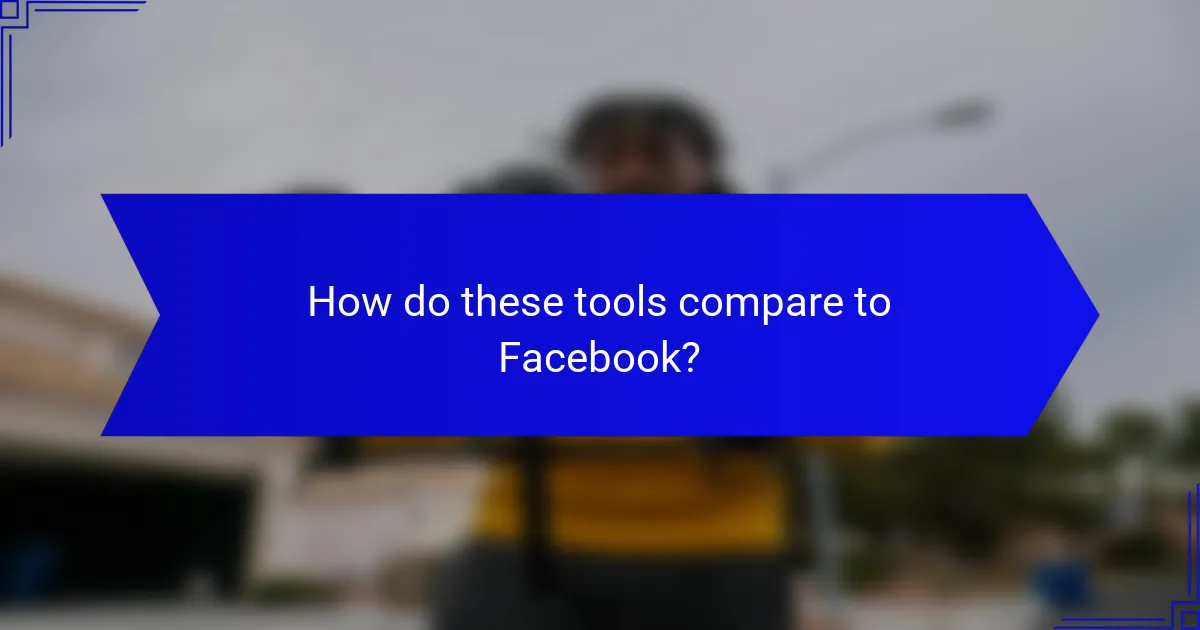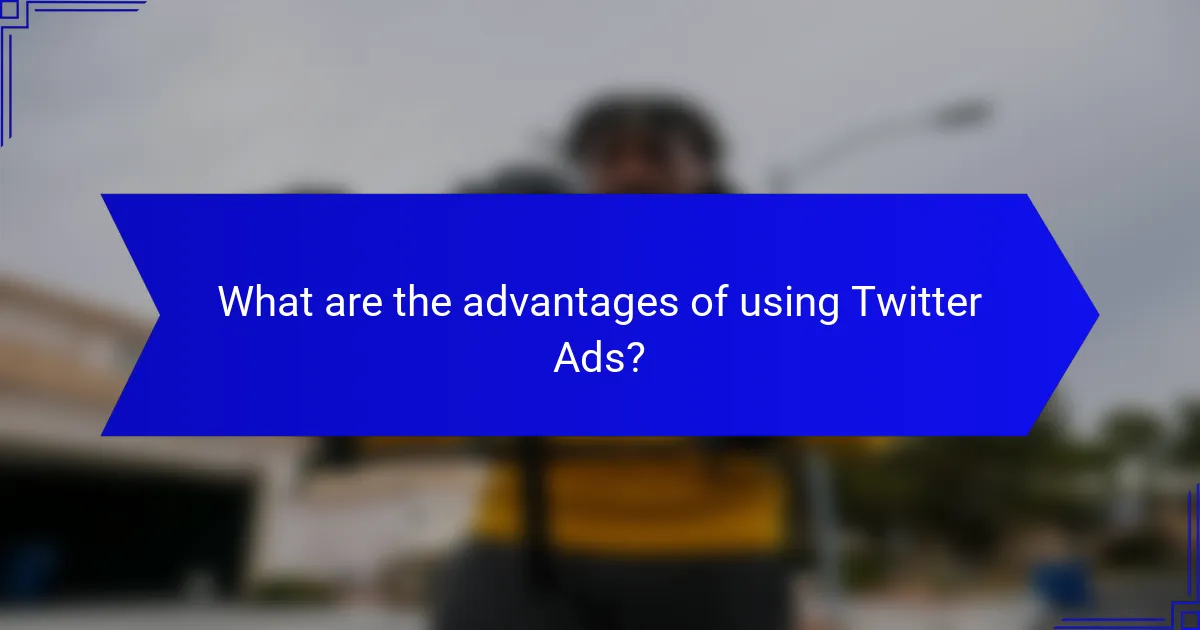In today’s digital landscape, businesses can explore several effective free marketing tools as alternatives to Facebook, enabling them to connect with their target audience without the constraints of traditional social media. These platforms not only offer diverse advertising options but also focus on unique engagement strategies that can enhance visibility and drive conversions. By leveraging tools like Google Ads, companies can utilize features such as keyword targeting and performance tracking to optimize their marketing efforts effectively.

What are the best free marketing tools as alternatives to Facebook?
Several effective free marketing tools can serve as alternatives to Facebook, allowing businesses to reach their target audience without relying on social media. These platforms offer various advertising options that can help increase visibility, engagement, and conversions.
Google Ads
Google Ads allows businesses to create targeted ads that appear in search results and on websites within the Google Display Network. With a pay-per-click model, you can control your budget and only pay when users click on your ads. Consider using keyword targeting to reach potential customers actively searching for your products or services.
To maximize your Google Ads effectiveness, focus on creating compelling ad copy and using relevant keywords. Regularly monitor your campaigns to adjust bids and improve performance. Many businesses find that even a small budget can yield significant results when optimized correctly.
Twitter Ads
Twitter Ads enable businesses to promote tweets, accounts, or trends to a broader audience. You can choose from various ad formats, including promoted tweets and trends, to engage users directly. This platform is particularly useful for real-time marketing and connecting with audiences during events or trending topics.
When using Twitter Ads, consider targeting specific demographics or interests to ensure your ads reach the right audience. Engaging visuals and concise messaging can enhance your ad’s effectiveness. Regularly analyze your campaign metrics to refine your strategy and improve engagement rates.
LinkedIn Marketing Solutions
LinkedIn Marketing Solutions is ideal for B2B marketing, allowing businesses to connect with professionals in specific industries. You can run sponsored content, text ads, or InMail campaigns to reach decision-makers directly. This platform is particularly effective for lead generation and brand awareness among a professional audience.
To succeed on LinkedIn, focus on creating high-quality content that resonates with your target audience. Utilize LinkedIn’s targeting options to narrow down your audience based on job title, industry, or company size. Regularly evaluate your campaign performance to optimize your approach and increase return on investment.
Pinterest Ads
Pinterest Ads enable businesses to promote visually appealing content to users seeking inspiration and ideas. This platform is particularly effective for brands in industries like fashion, home decor, and food. Promoted pins can drive traffic to your website and increase brand visibility among users interested in your offerings.
When creating Pinterest Ads, ensure your visuals are high-quality and engaging. Utilize keyword-rich descriptions to improve discoverability. Monitor your ad performance and adjust your strategy based on user engagement and conversion rates to enhance your overall effectiveness.
Snapchat Ads
Snapchat Ads provide a unique opportunity to reach a younger audience through engaging and interactive content. With options like Snap Ads, Story Ads, and Collection Ads, businesses can create immersive experiences that capture users’ attention. This platform is particularly effective for brands targeting millennials and Gen Z.
To make the most of Snapchat Ads, focus on creating short, captivating videos that convey your message quickly. Utilize Snapchat’s targeting features to reach specific demographics and interests. Regularly track your ad performance to refine your approach and maximize engagement with your audience.

How do these tools compare to Facebook?
Free marketing tools often provide different functionalities compared to Facebook, focusing on cost savings and alternative engagement strategies. While Facebook offers extensive reach and advanced features, other platforms can deliver effective marketing solutions with unique advantages.
Cost-effectiveness
Many free marketing tools allow businesses to promote their products without the financial burden associated with Facebook ads. Platforms like Mailchimp for email marketing or Canva for graphic design offer free tiers that can be sufficient for small businesses or startups.
When evaluating cost-effectiveness, consider the total cost of ownership, including any hidden fees or premium features that may be necessary for your marketing goals. Free tools can be a great starting point, but as your needs grow, you may need to invest in paid options.
Targeting capabilities
Facebook is known for its sophisticated targeting options, allowing businesses to reach specific demographics based on interests, behaviors, and location. In contrast, many free tools may offer limited targeting features, focusing more on broad outreach rather than precision.
For example, platforms like Twitter or LinkedIn allow for some targeting based on user interests or professional backgrounds, but they may not match Facebook’s depth. When using free tools, it’s essential to understand their targeting limitations and adapt your strategy accordingly.
User demographics
Facebook has a diverse user base, appealing to a wide range of demographics, including various age groups and interests. In comparison, other platforms may cater to specific audiences, which can be beneficial depending on your target market.
For instance, Instagram attracts a younger audience, while LinkedIn is primarily used by professionals. Understanding the user demographics of each platform can help you choose the right tools for your marketing efforts, ensuring that your message reaches the intended audience effectively.

What are the key features of Google Ads?
Google Ads offers a range of features that enable businesses to effectively reach their target audience through online advertising. Key features include keyword targeting, various ad formats, and robust performance tracking tools that help optimize campaigns for better results.
Keyword targeting
Keyword targeting in Google Ads allows advertisers to select specific words or phrases that potential customers might use when searching for products or services. This feature ensures that ads appear in relevant search results, increasing the likelihood of attracting interested users.
To maximize effectiveness, consider using a mix of broad match, phrase match, and exact match keywords. This strategy can help capture a wider audience while maintaining relevance. Regularly reviewing and updating your keyword list is essential to adapt to changing trends and user behavior.
Ad formats
Google Ads provides various ad formats, including text ads, display ads, video ads, and shopping ads. Each format serves different marketing goals and can be tailored to specific audiences. For instance, text ads are effective for search campaigns, while video ads can engage users on platforms like YouTube.
When choosing an ad format, consider your target audience and the message you want to convey. Experimenting with different formats can help identify which ones resonate best with your audience, ultimately improving engagement and conversion rates.
Performance tracking
Performance tracking in Google Ads is crucial for assessing the effectiveness of your campaigns. The platform provides detailed analytics on metrics such as click-through rates, conversion rates, and return on ad spend. This data allows advertisers to make informed decisions about budget allocation and campaign adjustments.
Utilizing tools like Google Analytics in conjunction with Google Ads can enhance tracking capabilities. Set specific goals and key performance indicators (KPIs) to measure success effectively. Regularly reviewing performance data helps identify trends and areas for improvement, ensuring your advertising efforts remain effective over time.

What are the advantages of using Twitter Ads?
Twitter Ads offer unique advantages for marketers, particularly in terms of real-time engagement and audience targeting. These ads can enhance brand visibility and drive immediate interactions with potential customers.
Real-time engagement
One of the key benefits of Twitter Ads is their ability to facilitate real-time engagement. Brands can connect with users as events unfold, allowing for timely responses to trending topics or customer inquiries. This immediacy can significantly boost user interaction and brand loyalty.
To maximize real-time engagement, consider using Twitter’s promoted tweets during high-traffic events or relevant news cycles. This strategy can help your content reach a broader audience quickly.
Hashtag promotion
Twitter’s hashtag functionality allows brands to promote specific campaigns or products effectively. By using targeted hashtags, businesses can increase the discoverability of their ads and encourage user participation in conversations around their brand.
When creating a hashtag campaign, ensure that your hashtags are unique and relevant to your audience. Engaging users with contests or discussions around these hashtags can further enhance visibility and interaction.
Audience insights
Twitter Ads provide valuable audience insights that can inform marketing strategies. Advertisers can access data on user demographics, interests, and behaviors, enabling them to tailor their campaigns more effectively.
Utilize Twitter’s analytics tools to monitor ad performance and audience engagement. This data can guide adjustments to your targeting and content, ensuring that your ads resonate with the right audience segments.

What should I consider when choosing a marketing tool?
When selecting a marketing tool, consider your specific needs, budget, and the features that align with your marketing strategy. Evaluate usability, integration capabilities, and customer support to ensure the tool effectively meets your goals.
Budget constraints
Budget is a critical factor when choosing a marketing tool. Many options are available, ranging from free tools to premium subscriptions that can cost hundreds of dollars monthly. Determine how much you can allocate for marketing tools and prioritize features that deliver the best return on investment.
For example, if your budget is limited, consider free tools like Mailchimp’s free tier for email marketing or Canva for graphic design. These options can provide essential functionalities without financial strain.
Features and functionality
Assess the features and functionality of marketing tools to ensure they align with your objectives. Look for tools that offer essential capabilities such as analytics, automation, and social media management. A tool that integrates multiple functions can save time and improve efficiency.
For instance, HubSpot offers a comprehensive suite that includes CRM, email marketing, and social media tools, making it a strong choice for businesses looking for an all-in-one solution.
User experience
User experience is vital for effective marketing tool adoption. A tool that is intuitive and easy to navigate will encourage team members to use it regularly. Look for platforms that offer a user-friendly interface and provide tutorials or customer support.
Consider tools like Buffer or Hootsuite, which are known for their straightforward dashboards that simplify social media management, making it easier for users to schedule posts and track engagement.
Integration capabilities
Integration capabilities are essential for ensuring that your marketing tools work seamlessly with other systems you use. Check if the tool can connect with your existing software, such as CRM systems, email platforms, or e-commerce solutions. This can enhance data flow and improve overall marketing effectiveness.
For example, Zapier allows you to automate workflows between various applications, enabling you to connect tools like Google Sheets with your email marketing software for streamlined operations.
Customer support
Reliable customer support can make a significant difference when using marketing tools. Look for providers that offer multiple support channels, such as live chat, email, or phone support. Good customer service can help you resolve issues quickly and minimize downtime.
Tools like ActiveCampaign provide extensive resources, including tutorials and responsive customer support, ensuring users can get assistance when needed.
